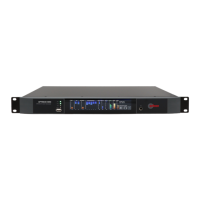2-8 Installation
1) LLHARD automatically defeats the compressor look-ahead. (This action is functionally equivalent to
setting the LOOK-AHEAD control to OUT, except that it reduces input/output delay by 5 ms).
2) LLHARD prevents the bass clipper from switching to Medium mode whenever speech is detected. By
constraining the system in these ways, it ensures that the delay is always 13 ms.
Switching the BASSCLIPMODE to LLHARD (from any other mode) removes five milliseconds of delay from the signal
path. If it occurs during program material, switching can cause audible clicks, pops, or thumps (due to waveform
discontinuity). If you have some presets with LLHARD bass clipper mode and some without, switching between
these presets is likely to cause clicks unless you do it during silence. However, these clicks will never cause
modulation to exceed 100%.
One of the essential differences between the HARD and LLHARD bass clipper modes is that switching between
HARD and MED does not change delay and is therefore less likely to cause audible clicks.
x Ultra-low latency processing uses a separate, parallel processing structure and is invoked by recalling any
“UL” preset. This structure operates simultaneously with other code, so, unlike the similar structure in
Orban’s OPTIMOD 8300, it does not require a code re-load and does not cause a gap in programming.
The only way to create an ultra-low latency user preset is to start with a “UL” factory preset and then edit
that preset. “UL” user presets cannot be directly converted to low latency or optimum latency presets
because the preset customization controls are different—UL presets have fewer available controls because of
the difference in processing structure.
UL presets are the closest emulations of OPTIMOD 8200 processing available in the 5950. These presets differ
from OPTIMOD 8200 processing in two main ways: (1) the 5950 UL presets still use the 5950’s stereo
enhancement, equalization section, advanced-technology AGC, composite limiter, and multiplex power
controller, and (2) the 5950 UL presets use anti-aliased clippers operating at 256 kHz sample rate.
Some talent moving from an analog processing chain will require a learning period to become accustomed to the
voice coloration caused by “bone-conduction” comb filtering. This is caused by the delayed headphone sound’s
mixing with the live voice sound and introducing notches in the spectrum that the talent hears when he or she
talks. All digital processors induce this coloration to a greater or lesser extent.
Fortunately, it does not cause confusion or hesitation in the talent’s performance unless the delay is above the
psychoacoustic “echo fusion” (Haas) threshold of approximately 20-25 ms and the talent starts to hear slap echo in
addition to frequency response colorations.
Low-Delay Monitoring: The 5950’s analog outputs can be switched to provide a low-delay monitoring feed with a
delay of 5-10 ms. This uses a separate instance of the Ultra-Low-Latency structure to allow the monitor to provide
a “FM-processed” sound. You can adjust the amount of “FM peak limiter sound” via the MONITOR DRIVE control.
If the talent relies principally on headphones to determine whether the station is on the air, simple loss-of-carrier
and loss-of-audio alarms should be added to the system. The 5950 can be interfaced to such alarms through any of
its eight its GPI remote control inputs, cutting off the low-delay audio to the talent’s phones when an audio or
carrier failure occurs.

